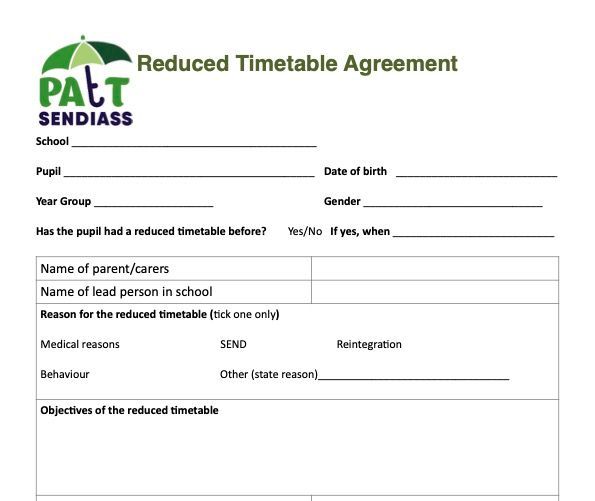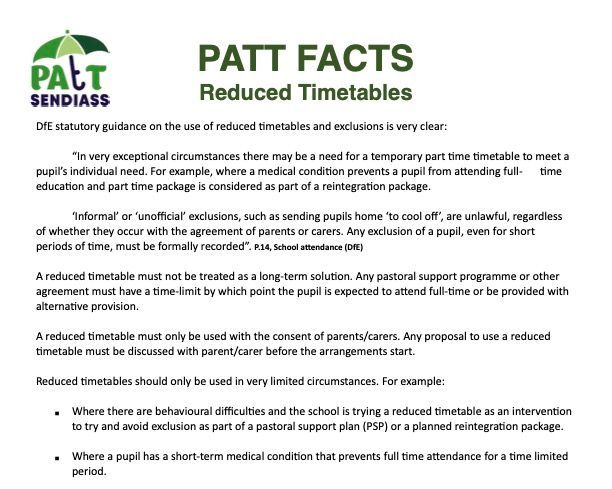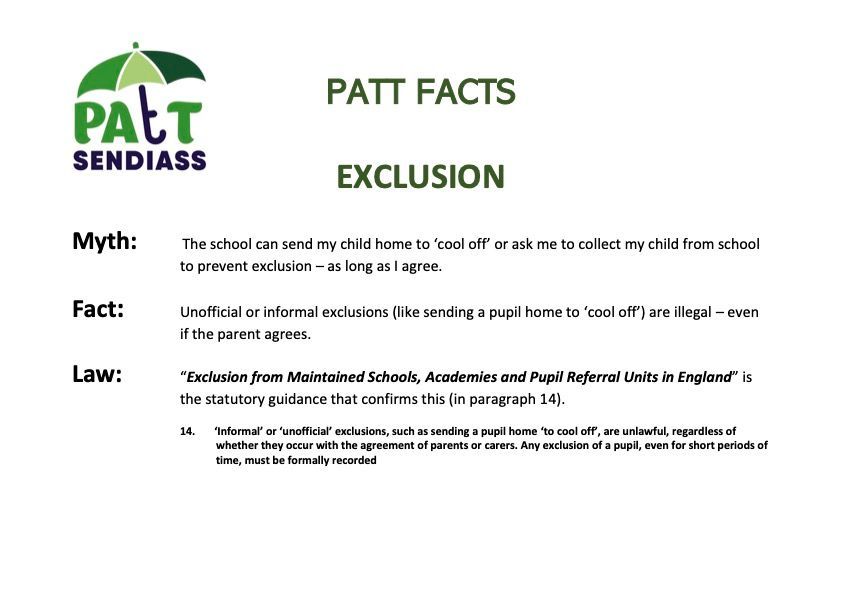Exclusions
What do I do if my child has been excluded from school?
If your child has been permanently excluded you can
email us or call the PATT Exclusion Support Line on
07711 749187.

What happens when your child is excluded?
Your child’s school will let you know about an exclusion as soon as possible. They’ll follow up with a letter telling you how long your child is excluded for and why.
You should also be told how to challenge the exclusion, should you want to.
Exclusions can start on the same day, but the school shouldn’t make you collect your child straight away.
For the first 5 school days of an exclusion, it is your responsibility to make sure your child isn’t in a public place during normal school hours unless there is a good reason.
You might be prosecuted if your child is found in a public place when they’re not supposed to be.
Information and Advice on School Exclusions
-
What types of exclusion are there?
There are five types of exclusion:
Suspension
Internal Exclusion (Isolation)
Permanent Exclusion
'Informal’ or ‘unofficial’ Exclusion
Off-rolling
-
What is Suspension?
A suspension is where your child is temporarily removed from school. They can only be removed for up to 45 school days in one school year, even if they’ve changed school.
A suspension can also be for parts of the school day. For example, if a pupil’s behaviour at lunchtime is disruptive, they may be suspended from the school premises for the duration of the lunchtime period. Lunchtime exclusions are counted as half a school day for statistical purposes and in determining whether a governing board meeting is triggered.
If a child has been suspended for a fixed period, schools should set and mark work for the first 5 school days.
If the suspension is longer than 5 school days, the school must arrange suitable full-time education from the sixth school day, e.g. at a pupil referral unit.
-
Challenging a fixed term exclusion?
You will get a letter from the school telling you what to do if you disagree with the suspension.
You can ask the school’s governing body to overturn the suspension if either:
Your child has been suspended for more than 5 days
The suspension means they’ll miss a public exam or national curriculum test
If the suspension is for 5 days or fewer, you can still ask the governors to hear your views, but they can’t overturn the headteacher’s decision.
-
What is Internal Exclusion (Isolation)
Internal exclusion, sometimes called segregation or isolation, is a form of exclusion in which a young person remains on the school premises but is separated from other students and removed from their normal classes.
Regulation of internal exclusions are almost non-existent and each school with have their own policies on how a breach of school rules is dealt with. However, like any disciplinary measure a school takes, they must be fair, proportionate, reasonable, and lawful.
-
Challenging an Internal Exclusion
If you are concerned about your child/young person’s internal exclusion, in the first instance, you should complain to the school using the school’s published complaints procedure. If you believe the exclusions are discriminatory, you can apply to the First Tier Tribunal for disability discrimination, or the County Court if you believe the discrimination is on the basis of an alternative protected characteristic.
-
What is Permanent Exclusion?
Permanent exclusion means your child has been expelled from school. The local authority must arrange full-time education from the sixth school day.
A decision to exclude a pupil permanently should only be taken:
in response to a serious breach or persistent breaches of the school's behaviour policy; and
where allowing the pupil to remain in school would seriously harm the education or welfare of the pupil or others in the school.
The decision on whether to exclude is for the head teacher to take. However, where practical, the head teacher should give the pupil an opportunity to present their case before taking the decision to exclude.
Whilst an exclusion may still be an appropriate sanction, the head teacher should take account of any contributing factors that are identified after an incident of poor behaviour has occurred. For example, where it comes to light that the pupil has suffered bereavement, has mental health issues or has been subject to bullying.
Early intervention to address underlying causes of disruptive behaviour should include an assessment of whether appropriate provision is in place to support any SEN or disability that a pupil may have. The head teacher should also consider the use of a multi-agency assessment for a pupil who demonstrates persistent disruptive behaviour. Such assessments may pick up unidentified SEN but the scope of the assessment could go further, for example, by seeking to identify mental health or family problems.
-
Challenging a Permanent Exclusion
You’ll be invited to a review meeting with the school’s governors if your child has been permanently excluded. This will happen within 15 school days.
If the governors don’t overturn the exclusion, you can ask for an Independent Review Panel Hearing. The Governors Hearing outcome letter must tell you how to do this.
If you think your child’s been discriminated against, you can make a claim to the SEND First Tier Tribunal. You need to do this within 6 months of the exclusion.
-
What are ‘Informal’ or ‘Unofficial’ Exclusions?
‘Informal’ or ‘unofficial’ exclusions such as sending a pupil home ‘to cool off’, are unlawful, regardless of whether they occur with the agreement of parents or carers. Any exclusion of a pupil, even for short periods of time, must be formally recorded.
-
Challenging 'Informal" or 'Unofficial' Exclusions
If you are being asked to take your child home at lunchtime or to “cool off”, these must be recorded. If the school is reluctant to give you the exclusion letter when you are collecting your child, you could ask them to complete PATT’s Informal exclusion from which will give you the details of the exclusion before you leave the school premises.
If you are having any difficulties with school regarding exclusions, you can make an appointment to meet with a member of the PATT SENDIASS team who can give you advice and an Exclusions Record Pack.
-
What is Off-Rolling
Off-rolling is the process of removing a child/young person from the school's register for the benefit of the school.
Off-rolling is unlawful. It includes any situation where the school has applied pressure to the family to remove the child from the school's register in order to benefit the school. For example, schools sometimes apply pressure to a family to opt for elective home education or a managed move, in order to remove the child/young person from the school community.
If you feel that you are being pressured to remove your child/young person from the school roll, seek advice before signing any documentation.
If you are having any difficulties with school regarding exclusions, you can make an appointment to meet with a member of the PATT SENDIASS team who can give you advice and guidance and provide an Exclusions Record Pack.
Weblinks to further information and support
We welcome your feedback! If you have used our services please click here to leave your opinion.
Contact us
Text: 07702 127 252
Text a message to request a call.
Telephone: 07702 127 252
Leave a message and you will receive a call back within 4 working days
Menu
Address
51 Lodge Lane,
Grays,
Essex.
RM17 5RZ
Email: info@patt.org.uk
All Rights Reserved | PATT SENDIASS THURROCK



